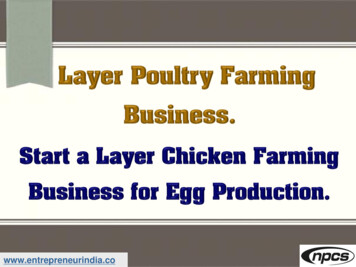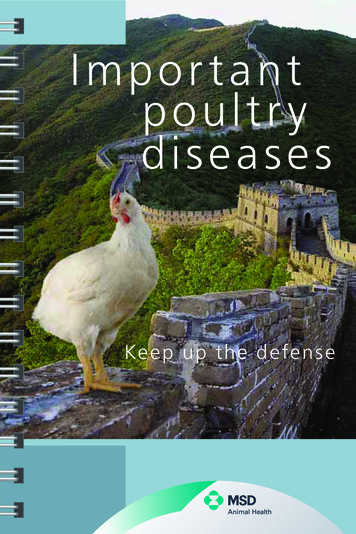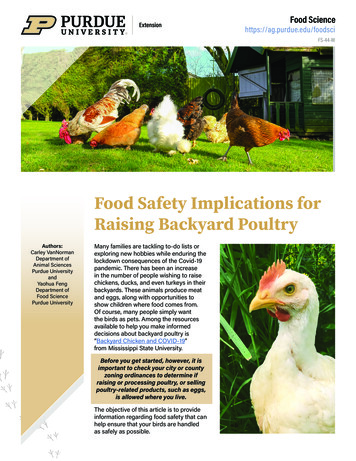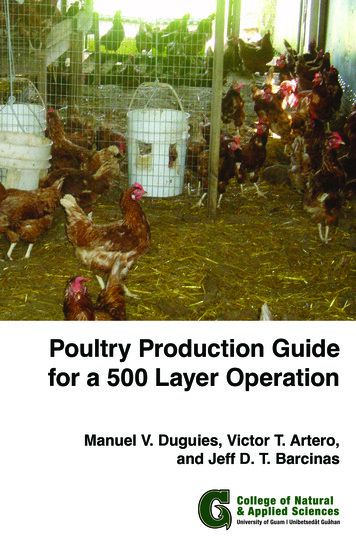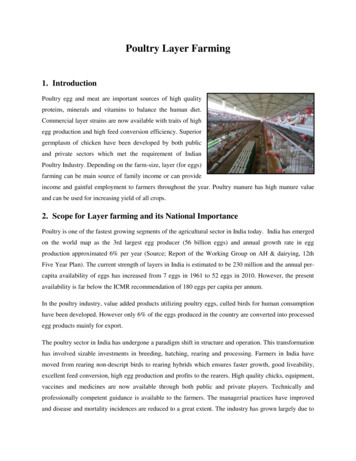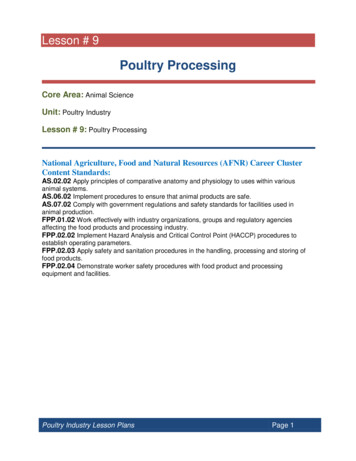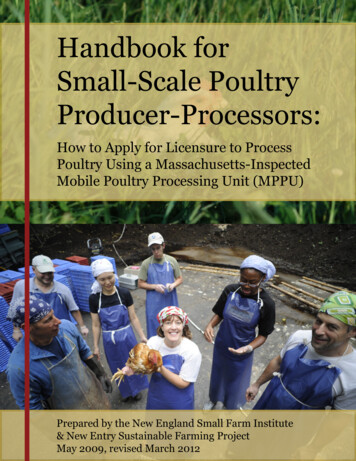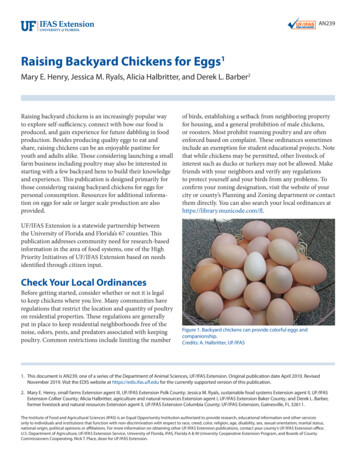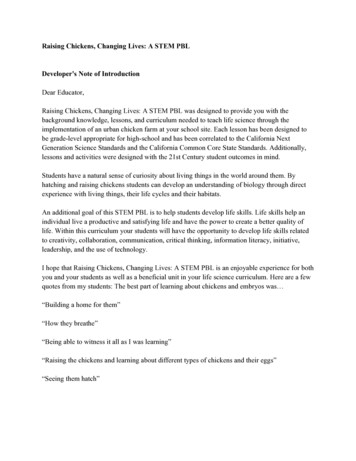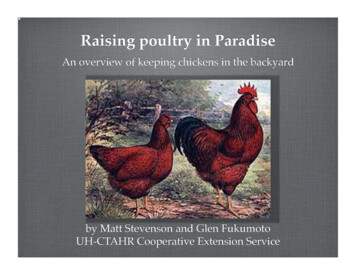
Transcription
Raising poultry in Paradise!An overview of keeping chickens in the backyard!by Matt Stevenson and Glen Fukumoto!UH-CTAHR Cooperative Extension Service!
47 Million*Farm Gate ValueDairy ( 9.7 M)Pork ( 3.7 M)Generating 141 Millionin Hawaii’s EconomyPoultry ( 7.4 M)Beef ( 26.2 M)*HASS, 2007
SurveyofConfinedOpera1ons1999to2008 1999 Broiler Dairy510 Layer Swine1130 Processors112008 0100% 280% 555% 21(‘04)30% 918% BeefCaIle82,000(‘04)82,700(’08)
Tasty, healthy Food!"Freshness is fundamental!"Eggs, nature’s perfect food?!"Your food, your responsibility!"Less food miles!
easy, low cost protein!""""Little space required!Low start-up andmaintenance costs!Not a huge timecommitment!Share the wealth!
Small Scale Confinement Pros Less laborSmall production areaStart-up costs lower ? Cons Manure build-up, odorsFlies, other vectors
Pastured System Cons More labor Pros Require “larger” areaEnvironment/Forageconsiderations No manure build-up.Direct nutrientapplication, stimulatenutrient cyclingEnhance naturalbehaviorsSupplemental feedthrough forage andinsect ‘grazing’
Names of the Chicken!Cockerel!Rooster!Pullet!Hen!Chick!
Physiology!""""Chickens’ vision andhearing are akin to humans!Poor sense of smell!No teeth, use crop store andgizzard to “chew” food!All chickens have combs,and all but Silkie’s havewattles!
Physiology!""""Sexes differentiate around 3and 8 weeks of age!Pullets reach sexual maturitybetween 16 and 24 weeks!Usually only 1 ovarymatures which houses aclump of immature yokes!Eggs are generally laid in themorning!
Behavior!"""""Pecking Order: chicken hierarchy,develops by 5-7 weeks old in new chicks!Change Stress, Stress LessProduction !Provide enough space and feed to avoidcannibalism!Dust bathing!Extremely intelligent with excellentmemory!
The egg!
Egg Characteristics!""""Contains all 22 essential amino acids, lacks onlyVitamin C !Second only to mother’s milk in protein quality; FAOranks eggs above dairy, fish, beef, and soybeans!Most eggs weigh around 2 oz.; 10% is shell; 60% iswhite; 30% is yolk!Egg shells can be green, brown, white, or speckled color has no effect on nutritional quality!
Egg characteristics!"Up to 10 times higher Omega-3 fatty acids frompastured hens - higher levels reduce risk for a suite ofdiseases!"60% more vitamin B12; 50% more folic acid!"34% less cholesterol in pasture based eggs!"Effects of fats and cholesterol dependent on who iseating them!
Egg quality!""Eggs are clean when laid, clean nest box clean eggs!The cuticle or “bloom” is removed with mechanicalwashing and may shorten shelf life!"Albumen has major influence on internal quality!"As the hen ages, albumen quality decreases!"Blood spots in eggs are normal and edible!
Egg quality!
Egg quality!
Breeds!Layers!Meat!"Leghorn!"Cornish dalusian!"Shamo!
Breeds!Rhode Is. Red!Araucana!Plymouth Rock!Australorp!New Hampshire!Buff Orpington!
Meat birds!"Called broilers & fryers!"Mature in 6-12 weeks!"Pasture raised birds take longer to mature!"Flavor and health benefits similar to pastured eggs!"Simple to process, no specialized equipment!
Processing!
Processing!"6-8 hour fasting period!"Immobilize - cone or line!"""Cut jugular (not windpipe)and drain blood completely!Immerse in 125F water for 30to 75 seconds!Pick feathers immediatelyusing rubbing action!
Processing!"Remove head, neck, shanks, and oil gland!"Eviscerate !"Rinse clean thoroughly!"Submerge in ice water to 40F before packing ( 2hrs)!"Drain completely before bagging and storing!
Basic Nutrition Water Energy Protein (Lysine, Methionine) Calcium, Phosphorus
Daily Nutrient Requirements of Chickens*TypeCP (g)Layer Chicks1.7 - 16.50 wks - 1st eggBroilers0 - 9 wksLaying HensEnergyMethion.Lysine (g)(kcal/kg)(g)Calcium(g)Phosph.(g)2800 - 28500.05 - 0.760.02 - 0.330.18 - 3.60.04 - 0.284.4 - 40.532000.2 - 1.90.1 - 0.720.19 - 1.80.09 - 0.6816.529000.760.333.60.28*From National Research Council, 1994
Temperate Feedstuffs Energy Grains (corn, sorghum, othergrains) Protein grains (soybeans) Forages (alfalfa)
Tropical Feedstuffs Energy (cassava, taro, breadfruit, sweetpotato, yam, coconut, banana, macadamia) Protein (pigeon peas) Forages (clovers, perennial peanut, leafyperennials)
Other Potential Feedstuffs Food wastes (bakery products, wheat mill run) Protein (meat and bone meal) Other crop industries (vegetable, papaya)
ForageProduc1onandAlterna1veFeeds Alterna1veFeeds Perennialpeanut Stoloniferousgrasses,legumes Cullfruitsandvegetables Leafyperennials Other:pigeonpeas,sorghum
Es1ma1ngForageProduc1on
Optimum Levels in Rationsof Selected Ingredients*FeedstuffCitrus pulpCoconut meal/cakeCoffee groundsLeucaena leafPalm kernel mealPalm oilSugar cane molassesOptimum Level (%)5 - 105 - 153-52 - 510 - 402 - 810 - 30*Adapted from Hutagalung, 1981 in Sonaiya and Swan, 2004
“All-Hawaiian Emergency Ration*”FeedstuffRation 1 (%)Ration 2 (%)15--1755-Corn-54Pigeonpea meal7-Soybean oil meal-3Peanut oil meal-315-Pineapple bran (fine)-15Koa haole seed meal55Salt11Coral sand22100100Fish mealMeat scrapsSorghum (milo)Kiawe bean mealTotal*Adapted from Bice, 1947 - “The birds on the above ration averaged 55% production over theduration of the experiment which lasted for a period of 6 months” (pg 17).
Rota1onalGrazingManagement dfeedgrains. onandwaterholdingcapacity ingplantvigor. Improvesplantcommuni1esandreducesweedcompe11on.
Rota1onalGrazingManagement wth. Reduceenvironmentalconcernsofmanurebuild- ‐up,odors,nuisancevectors. Pathogensreducedthroughsolardisinfec1on. ople. Animalsarecontrolledinawellmanagedsystem
Examples of Grazing Rotations4-cycle rotation28-cycle rotation
0- ‐drest5- ‐drest12- ‐drest
From chick to molt!Overview of laying systems!
Picking up chicks!""""Cardboard box withbedding and space at0-4 weeks: 0.5 ft2/bird!Food, Water, Heat,Protection!Need to keep day oldchicks warm: 90-95F !Avoid hard surfaces!
Transition!""""Medicated or Nonmedicated feed?!4-8 weeks: 1ft2/bird! 6 weeks switch tolower %CP ration!8-12 weeks move topasture & lay ration!
She’s got eggs!""""First, small eggs laid between16-24 weeks of age!Will lay for about 12-18 monthsbefore “molting”!Rate of lay will be about 65-85%of lay before molt!Purchase or hatch replacements4-6 months before molt!
in the end.!
One last test.!
Raising poultry in Paradise! An overview of keeping chickens in the backyard! by Matt Stevenson and Glen Fukumoto! UH-CTAHR Cooperative Extension Service! Dairy ( 9.7 M)! Beef (
